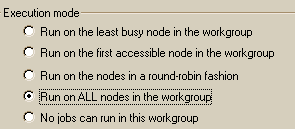Step 2a: Execution mode
The job's execution mode determines how jobs assigned to a workgroup will be processed. The choices are:
- Run on the least busy node in the workgroup - This selection will cause the scheduler to choose the node that is currently running the least number of jobs based on it's power rating, job limit and Vote count.
- Run on the first accessible node in the workgroup - This selection will cause the scheduler to find the node that is first accessible based on it's order in the members list.
- Run on all nodes in a round robin fashion - This selection will run jobs throughout the Workgroup in a round robin fashion. In other words, the first job will run on the first node in the Workgroup, the second will run on the second node, etc.
- Run on ALL nodes in the workgroup - This selection will cause the scheduler to run every job on every node. Keep in mind that this will cause multiple runs of each job. Once a job runs with the run-on-all workgroup type, all downstream jobs are required to be controlled by a workgroup that is also of type run-on-all. In addition, the node where each job instance is running must be a member of that workgroup.
- No jobs can run in this workgroup - No jobs will run in the Workgroup

 For this tutorial we are going to create a workgroup that runs jobs on all nodes. This is commonly used for things like performing maintenance, running reports, resetting passwords etc. across all nodes a network.
For this tutorial we are going to create a workgroup that runs jobs on all nodes. This is commonly used for things like performing maintenance, running reports, resetting passwords etc. across all nodes a network.
- For this example, click on the Run on ALL nodes in the workgroup radio button. The Execution mode is now set.

![]()
![]() For this tutorial we are going to create a workgroup that runs jobs on all nodes. This is commonly used for things like performing maintenance, running reports, resetting passwords etc. across all nodes a network.
For this tutorial we are going to create a workgroup that runs jobs on all nodes. This is commonly used for things like performing maintenance, running reports, resetting passwords etc. across all nodes a network. 